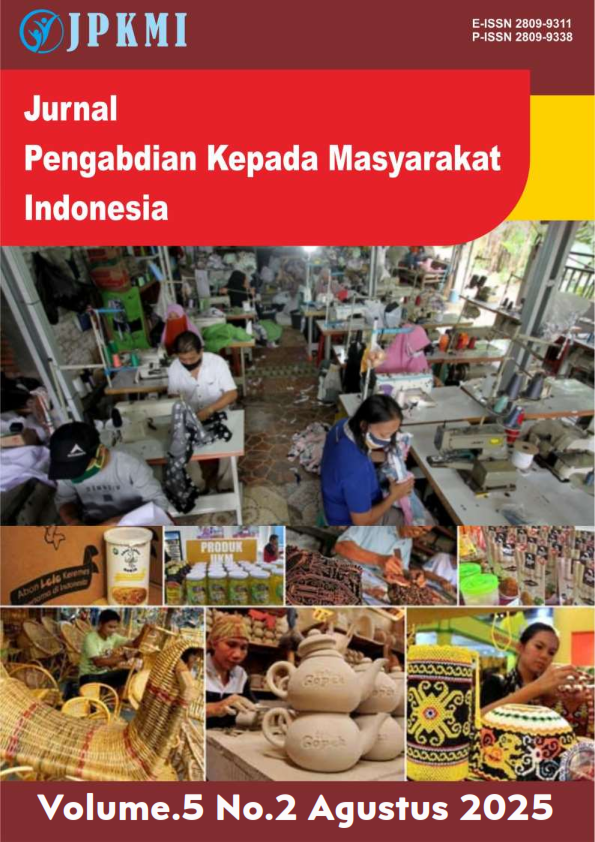Program GEMAS (Gerakan Masyarakat Sehat): Upaya Deteksi Dini dan Peningkatan Kesadaran Penyakit Tidak Menular
DOI:
https://doi.org/10.55606/jpkmi.v5i2.7961Keywords:
Non-Communicable Diseases, Hypertension, Health Screening, Community Service, Metabolic SyndromeAbstract
Non-communicable diseases (NCDs) such as hypertension, diabetes, and dyslipidemia have become a major health burden in Indonesia, with many cases remaining undiagnosed due to their asymptomatic nature. Early detection through community screening is a key prevention strategy. Objective: This community service activity, 'Gerakan Masyarakat Sehat' (GEMAS), aimed to conduct health screenings for the early detection of NCD risk factors among the residents of Jembrak Village, Semarang Regency. Methods: The activity was carried out on June 14, 2025, by lecturers and students from the Faculty of Health Sciences, Satya Wacana Christian University. Free examinations included blood pressure, random blood glucose, cholesterol, and uric acid levels for 29 residents. Results: The findings revealed a high prevalence of risk factors: 51.8% of participants had above-normal blood pressure (prehypertension and hypertension), 10.7% were identified with prediabetes, 39.2% had dyslipidemia, and 37.9% suffered from hyperuricemia. Many participants exhibited a clustering of more than one risk factor. Conclusion: This screening program effectively unveiled the hidden burden of NCDs within the community. It underscores the importance of proactive early detection programs, with referral to the local primary health center (Puskesmas) being a crucial step for further management and complication prevention.
References
Ashgar, R. I. (2025). Community- based Participatory Research in Cardiovascular Disease Prevention for Middle- aged Women: A Systematic Review. TOUCH MEDICAL MEDIA, 12–19. https://doi.org/https:// doi. org/ 10. 17925/ HI. 2025. 19. 1.1
Bloom, D. E., Chen, S., McGovern, M., Prettner, K., Candeias, V., Bernaert, A., & Cristin, S. (2015). Economics of Diseases in Indonesia. World Economic Forum, (April), 1–16. Retrieved from http://www3.weforum.org/docs/WEF_The_Economics_of_non_Disease_Indonesia_2015.pdf
Dewi, S. S., Sriyati, S., & Harun, S. (2025). Hubungan Health Literacy dengan Self Care Management pada Pasien Diabetes Melitus Tipe 2. Jurnal Sehat Indonesia (JUSINDO), 7(2), 655–661. https://doi.org/10.59141/jsi.v7i2.268
Elsayed, N. A., Aleppo, G., Aroda, V. R., Bannuru, R. R., Brown, F. M., Bruemmer, D., … Gabbay, R. A. (2023). 2. Classification and Diagnosis of Diabetes: Standards of Care in Diabetes—2023. Diabetes Care, 46(January), S19–S40. https://doi.org/10.2337/dc23-S002
Firdayanti, F., Idris, S. A., & Arfan, A. (2023). Analisis Kadar Asam Urat Serum Pada Individu Dengan Gagal Ginjal Kronik. SENTRI: Jurnal Riset Ilmiah, 2(8), 3251–3257. https://doi.org/10.55681/sentri.v2i8.1264
Franc¸ois Mach, et all. (2020). 2019 ESC/EAS Guidelines for themanagement ofdyslipidaemias: lipidmodification to reduce cardiovascular risk The Task Force for the management of dyslipidaemias of the European Society of Cardiology (ESC) and European Atherosclerosis Society (EAS). European Heart Journal, 111–188. https://doi.org/10.1093/eurheartj/ehz455
Herningtyas, E. H., & Ng, T. S. (2019). Prevalence and distribution of metabolic syndrome and its components among provinces and ethnic groups in Indonesia. BMC Public Health, 19(1), 1–12. https://doi.org/10.1186/s12889-019-6711-7
Kemenkes RI. (2022). Profil Kesehatan Indonesia 2021. In Pusdatin.Kemenkes.Go.Id.
Kemenkes RI. (2024). Laporan Tematik Survey Kesehatan Indonesia Tahun 2023. In Kemenkes RI. Retrieved from 10
Nurhasan, M., Ariesta, D. L., Utami, M. M. H., Fahim, M., Aprillyana, N., Maulana, A. M., & Ickowitz, A. (2024). Dietary transitions in Indonesia: the case of urban, rural, and forested areas. Food Security, 16(6), 1313–1331. https://doi.org/10.1007/s12571-024-01488-3
PERKI. (2022). Panduan Tatalaksana Dslipidemia 2022. Perhimpunan Dokter Spesialis Kardiovaskular Indonesia Panduan. Retrieved from http://inaheart.org/panduan-tatalaksana-dislipidemia-2022/
Purwito, D., Linggardini, K., & Jaitieng, A. (2025). Barriers To Healthcare Access : Examining Travel Time , Waiting Times , And Service Costs in Indonesia Primary Health Care. 18(2), 236–245.
Whelton, P. K., Carey, R. M., Mancia, G., Kreutz, R., Bundy, J. D., & Williams, B. (2022). Harmonization of the American College of Cardiology/American Heart Association and European Society of Cardiology/European Society of Hypertension Blood Pressure/Hypertension Guidelines: Comparisons, Reflections, and Recommendations. Circulation, 146(11), 868–877. https://doi.org/10.1161/CIRCULATIONAHA.121.054602
WHO. (2023). Invisible numbers The true extent of noncommunicable diseases and what to do about them. In World Health Organization.
Downloads
Published
How to Cite
Issue
Section
License
Copyright (c) 2025 Jurnal Pengabdian kepada Masyarakat Indonesia (JPKMI)

This work is licensed under a Creative Commons Attribution-ShareAlike 4.0 International License.









